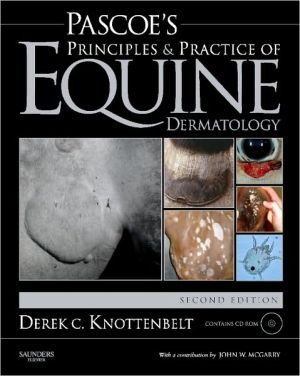Pascoe's Principles and Practice of Equine Dermatology
Professor Knottenbelt’s approach is clear, authoritative and based on many years experience in treating equine dermatological conditions. The book presents over 650 photographs, most of them new and unique to this edition, and the accompanying CD-ROM offers an image library with over 300 extra illustrations. The new edition is designed as a fully practical, highly illustrated guide to skin diseases in the horse. It emphasizes how to obtain an accurate differential diagnosis and arrive at...
Search in google:
Professor Knottenbelt’s approach is clear, authoritative and based on many years experience in treating equine dermatological conditions. The book presents over 650 photographs, most of them new and unique to this edition, and the accompanying CD-ROM offers an image library with over 300 extra illustrations. The new edition is designed as a fully practical, highly illustrated guide to skin diseases in the horse. It emphasizes how to obtain an accurate differential diagnosis and arrive at correct decisions for the appropriate treatment of a condition. The book includes the full range of skin diseases and conditions commonly encountered in equine practice. Rarer disorders and those with a limited geographical distribution are also reviewed, and there are separate chapters on diseases of the hoof, skin wounds, neoplastic diseases and the various dermatologic syndromes that are encountered in the horse.• A practical guide emphasizing how to distinguish conditions of similar appearance but different implication for diagnosis, management, and prognosis. • A unique ready reckoner (key points chart) is included in each disorder to allow rapid summary information acquisition and use for practitioners and students at all levels. • Offers expert guidance with algorithms for decision making and treatment choices and considers syndromes as well as the diseases involved in the differential diagnosis and investigation. • Focuses on commonly encountered skin diseases but includes rarer disorders. • Covers skin conditions of the horse occurring worldwide. • An extensive unique section on neoplastic disease is included. • Includes discussion of hoof disorders and skin wounds. • Superbly illustrated with over 650 full-colour figures. • Contains CD-ROM with image library offering over 300 extra illustrations.• fully updated through-out • includes new colour illustrations Doody Review Services Reviewer:Karen L Campbell, DVM, MS, DACVIM, DACVD(University of Illinois College of Veterinary Medicine)Description:This excellent book on equine dermatology is described as a second edition, but it has been extensively updated with nearly twice the content of the 1999 edition. The book is divided into three parts: part 1 (chapters 1-4) covers basic principles of equine dermatology; part 2 (chapters 5-18) consists of disease profiles; and part 3 (chapter 19) details syndromes in equine dermatology. The book includes a CD-ROM with PowerPoint slides and over 300 extra illustrations.Purpose:The aims are to give the readers confidence in their ability to differentiate between normal variations and dermatological disease, knowledge of effective diagnostic skills and appropriate treatments, and a reference that provides easily accessible information. These are worthy objectives and this book will enhance the ability of readers to successfully diagnose and treat dermatological diseases affecting horses. Audience:Written for veterinary students and practitioners, the book will be of particular interest to veterinarians with an interest in equine dermatology. The author is a diplomate of the European College of Equine Internal Medicine and is recognized as an expert in equine dermatology and oncology. Features:The book is richly illustrated with over 650 color figures plus extensive tables and boxes to summarize important information. Additionally, the author has devised a unique system of "25 key point codes" to alert readers to helpful facts about the identification, diagnosis, prognosis, and management of each disease. The weakest feature is the index, which could be more comprehensive.Assessment:This is a must-have book for everyone with an interest in equine dermatology. It has been extensively updated and is organized in a very reader friendly format. For example, the discussion of each disease includes a profile (overview), clinical signs, differential diagnosis, diagnostic confirmation, treatment, and a table with key points. However, it is not as extensively referenced as Equine Dermatology, Scott and Miller (Elsevier, 2003), and those wanting a more thorough discussion of the diseases will want to own both books.
Part I—Principles and TechniquesIntroduction to clinical equine dermatologyThe approach to the equine dermatological caseDiagnostic/investigative testsPrinciples of dermatological therapeuticsPart II—Syndromes in Equine DermatologySyndromes in equine dermatologyPart III—Disease ProfilesSection A—Infections DiseasesViral diseasesBacterial diseasesFungal diseasesProtozoal diseasesMetazoan/ parasitic diseasesSection B—Noninfectious DiseasesCongenital/ developmental diseasesImmune-mediated/ allergic diseasesChemical and toxic dermatosesEndorcrine disordersNutritional disordersLatrogenic and idiopathic disordersPhysical and traumatic disordersInjuries and diseases of the hoofNeoplastic onditionsReferencesIndex
\ Reviewer: Karen L Campbell, DVM, MS, DACVIM, DACVD(University of Illinois College of Veterinary Medicine)\ Description: This excellent book on equine dermatology is described as a second edition, but it has been extensively updated with nearly twice the content of the 1999 edition. The book is divided into three parts: part 1 (chapters 1-4) covers basic principles of equine dermatology; part 2 (chapters 5-18) consists of disease profiles; and part 3 (chapter 19) details syndromes in equine dermatology. The book includes a CD-ROM with PowerPoint slides and over 300 extra illustrations.\ Purpose: The aims are to give the readers confidence in their ability to differentiate between normal variations and dermatological disease, knowledge of effective diagnostic skills and appropriate treatments, and a reference that provides easily accessible information. These are worthy objectives and this book will enhance the ability of readers to successfully diagnose and treat dermatological diseases affecting horses. \ Audience: Written for veterinary students and practitioners, the book will be of particular interest to veterinarians with an interest in equine dermatology. The author is a diplomate of the European College of Equine Internal Medicine and is recognized as an expert in equine dermatology and oncology. \ Features: The book is richly illustrated with over 650 color figures plus extensive tables and boxes to summarize important information. Additionally, the author has devised a unique system of "25 key point codes" to alert readers to helpful facts about the identification, diagnosis, prognosis, and management of each disease. The weakest feature is the index, which could be more comprehensive.\ Assessment: This is a must-have book for everyone with an interest in equine dermatology. It has been extensively updated and is organized in a very reader friendly format. For example, the discussion of each disease includes a profile (overview), clinical signs, differential diagnosis, diagnostic confirmation, treatment, and a table with key points. However, it is not as extensively referenced as Equine Dermatology, Scott and Miller (Elsevier, 2003), and those wanting a more thorough discussion of the diseases will want to own both books.\ \








